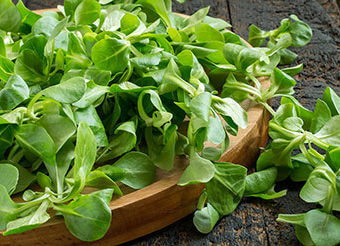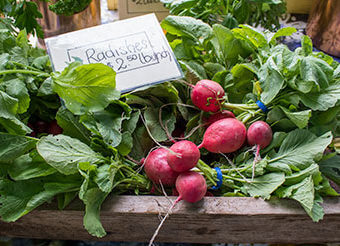There are plenty of options for seeds that thrive when sown in late summer. The average first frost date for regions like Lower Mainland BC and neighbouring areas (Sunshine Coast, Gulf Islands, coastal Vancouver Island, Puget Sound, Willamette Valley) is around November 2. That's still about eleven weeks of lush growing time left for us before the cold nips at our unprotected crop.
If you're gardening a different region, a quick search engine query with "first frost date" and your town's name will get you the information you need.
With a touch of crop protection, we can stretch the season even further. Now's the perfect time to plant fall and winter harvest vegetables and get some cover crops going. Here's our list of seeds to sow in mid-August, along with some tips and insights:

Arugula loves the cool soil and chilly weather. Keep an eye on the weather forecast, and once nighttime temperatures dip to 15°C (60°F) or lower, it's time to sow these delightful arugula seeds. Just don't plant them all at once. Here's the grand plan: sow a short row every two weeks until around the third week in September. Speaking of arugula, have you tried the magnificent Astro Organic? It stays mild and makes an excellent micro-green too.

Corn Salad is the unsung hero of the salad greens. Just like arugula, it loves the same planting conditions but boasts even more cold-hardiness. That means you can harvest this succulent veggie well into winter. This is a hidden gem you need to try. And for our friends in Europe, you might know it as Mache or Vit.

Carrots, the vibrant orange wonders that will steal your heart. Lucky for you, there are still over 75 glorious days left in the season for these lovely roots to thrive. Plant them in the next two weeks to ensure you reap the bountiful fall harvest. Carrot-growing tip: keep the seed bed well-watered until germination, especially on those toasty days above 25°C (77°F). Cover the soil with a tarp or lumber to minimize evaporation. Need more carrot wisdom? Check out our guide on How to Grow Carrots.

Endive and Radicchio are the dynamic duo of deliciousness that deserves more love. Some call them "bitter," but trust us, that's a good thing. Different is delightful, and these greens add a savory twist to your dishes. Say goodbye to the same old salads, and give them a whirl. Need some inspiration? Check out our Simple Radicchio Salad recipe.

Kale never fails to amaze us. Planting in mid-August means a bountiful harvest well into winter. If you still can't get enough of Kale's goodness after a summer-long supply, it's time to give winter planting a try. Kale is the superhero of winter crops, and growing it is as easy as a summer breeze.

Lettuce is the true champion of cool-season growing. You can still plant it now and watch it mature gracefully before the frost arrives. For an extra layer of fun, try some cold-hardy varieties like Winter Density and Rouge d’Hiver for post-frost harvesting. Plant a couple of early maturing loose-leaf types this week, and then add some cool-loving romaines in two weeks’ time. If you're lucky enough to have a greenhouse, think of lettuce as your winter veggie savior for an endless supply of freshness.

Mesclun mixes are the salad lovers' best friend. Into containers or short rows, these greens are ready to dazzle. And the best part? Since they're harvested young, after just four weeks, you can plant them multiple times. By sowing more seeds every two weeks, you'll have an abundance of fresh, crisp salad greens all fall long. We recommend trying our West Coast Market Mix to level up your salad game.

Try the marvelous Mustard family. From frilly Mizuna to the impressive Giant Red, these salad greens bring variety to your plate. They don't mind the cool soil at all; in fact, they thrive in it. Just like arugula and corn salad, plant mustard greens now, and they'll be your delightful companions for fall and winter salads. Our personal favorite? Komatsuna – a winter vegetable superstar. Raw or cooked, it's simply marvelous and utterly trouble-free to grow.

Pac choi, the cool-weather champion, is a must for your fall garden. Its growth slows down as autumn approaches, making it easier to harvest at its peak before bolting. If you haven't explored the deliciousness of pac choi in soups, stir-fries, pickles, sautés, or salads, now's the time to give it a whirl. These veggies are a breeze to grow in containers or garden beds, and they offer both speed and nutrition. With a variety of sizes and flavors, pac choi brings endless culinary delights.

Radishes adore cool soil, and they mature lightning fast from fall plantings. Go for short rows every couple of weeks for a continuous harvest. Want to try something exotic? The watermelon radish is a winter veggie star that thrives in cold soil. It's a perfect winter delight, and an October planting suits it best.

Spinach seeds in late summer? You bet! Plant some spinach rows in the third week of August for a bountiful fall harvest. But here's the trick – don't pull up the plants after harvesting. Leave the roots intact, and next spring, you'll be rewarded with an early, mega harvest of spinach before the pests even think about showing up. Our personal favorite is the French heirloom Monstrueux de Viroflay. Its springtime leaves are huge, tender, and delicious.

Cover Crop seeds are the superheroes of unused garden spaces. Barley, buckwheat, and oats are the best choices for this time of year. They can all be tilled under before the frost, giving your soil a well-deserved treat. Barley and oats can stay to form a protective mulch, keeping the soil in place and reducing weed pressure. Plus, they add ample carbon to the soil for your spring planting endeavors.
Before we sign off, a friendly reminder to place your orders for our Seed Garlic for Fall Planting. You won't want to miss out on this garlic goodness shipping across Canada in September and October.






















